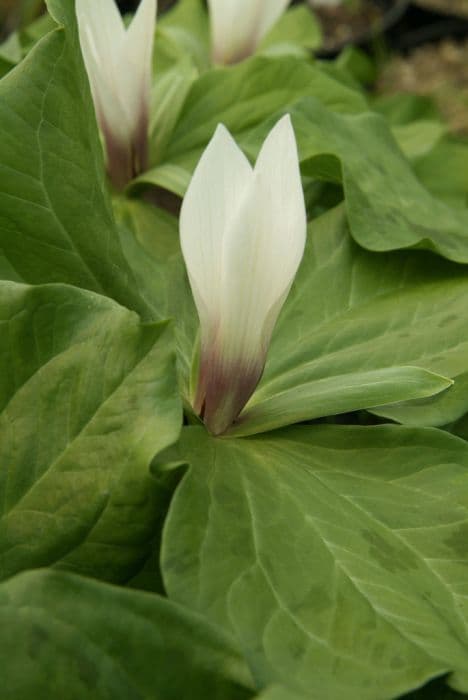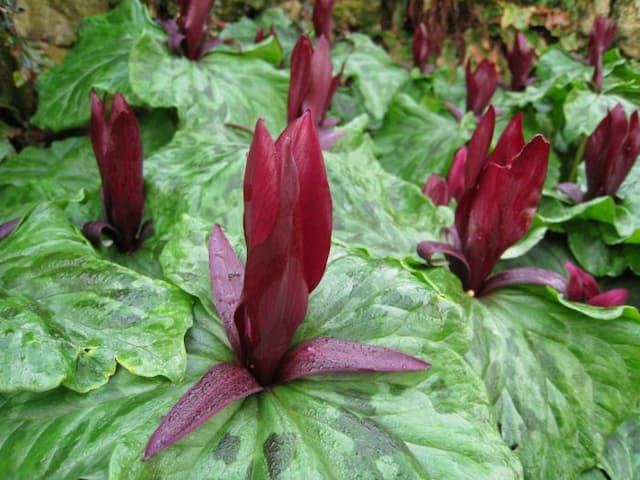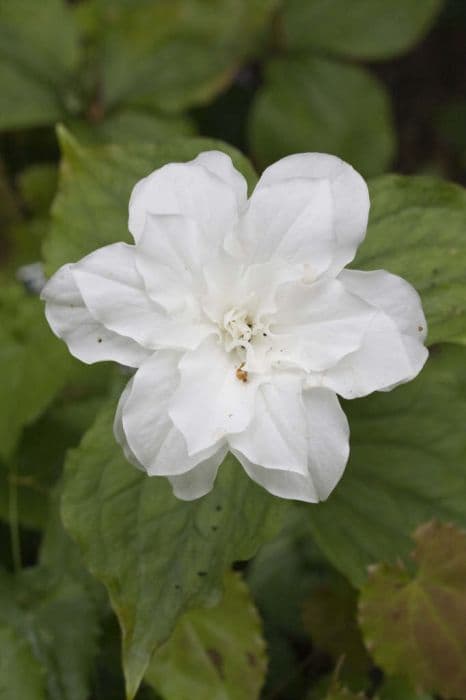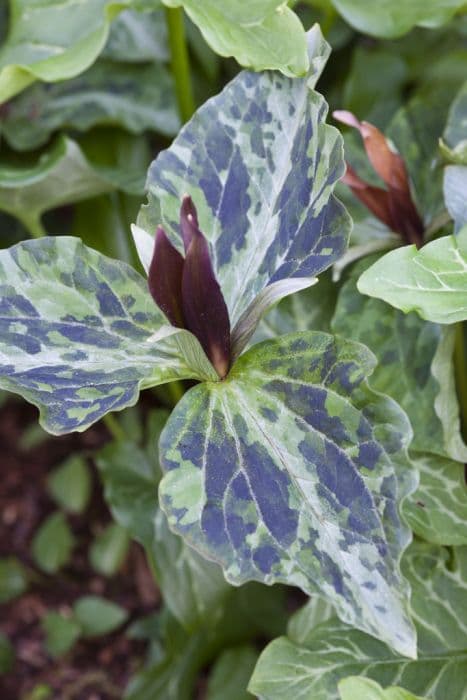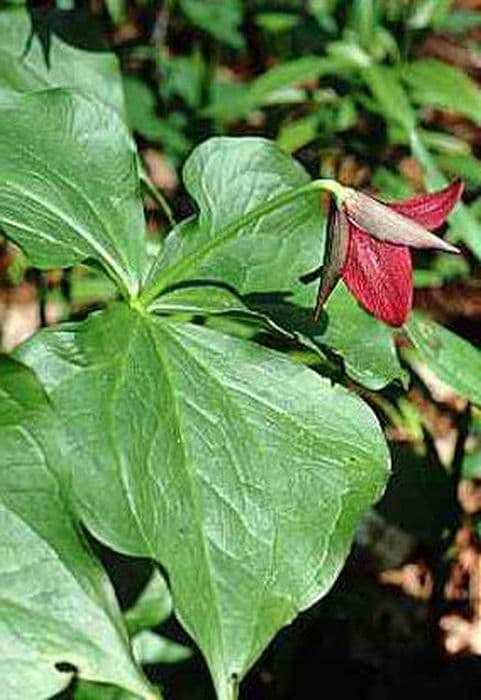Bent Trillium Trillium flexipes

ABOUT
Trillium flexipes, commonly known as the Bent Trillium or Drooping Trillium, is a perennial plant that is easily identified by its three broad leaves arranged in a whorl about the stem. Each leaf is generally diamond-shaped and has a visibly veined pattern. Atop the center of this whorl of leaves, a single flower emerges on a stalk that can either be erect or bent downward, hence the name "Bent Trillium." The flower consists of three large, white petals that are often recurved, creating an elegant and somewhat nodding appearance. The petals surround a set of three smaller sepals and a cluster of stamens with prominent yellow anthers that contrast with the white petals. In the center, there is a single pistil. The overall effect is that of a poised and symmetrical plant, with a distinctive flower that stands out against the backdrop of green foliage.
About this plant
 Names
NamesFamily
Melanthiaceae
Synonyms
Nodding Wakerobin, Bent Trillium, Drooping Trillium, Twisted Trillium, White Trillium
Common names
Trillium flexipes.
 Toxicity
ToxicityTo humans
Trillium flexipes, commonly known as the "bent trillium" or "drooping trillium," is not widely documented as being toxic to humans. There is limited information available on the toxicity of this specific species, but trilliums generally are not considered as poisonous plants. However, as a precaution, ingesting any part of wild plants without clear evidence of safety is not recommended. Should accidental ingestion occur, it is advisable to consult a medical professional, especially because individual allergies or adverse reactions are always a possibility when it comes to plant consumption.
To pets
Bent trillium is not widely recognized for having toxic properties that would be harmful to pets. There is little evidence to suggest that Trillium flexipes poses a significant threat if ingested by pets such as cats and dogs. Nevertheless, it is still wise to keep an eye on pets and prevent them from eating plants, as individual animals can react differently to various substances. Should your pet consume parts of the bent trillium and exhibit abnormal symptoms, seek veterinary care as a precaution.
 Characteristics
CharacteristicsLife cycle
Perennials
Foliage type
Deciduous
Color of leaves
Green
Flower color
White
Height
1-2 feet (30-60 cm)
Spread
1 foot (30 cm)
Plant type
Herb
Hardiness zones
4
Native area
North America
Benefits
 General Benefits
General Benefits- Ecosystem support - Serves as a food source for pollinators such as bees and supports local wildlife.
- Garden aesthetics - With its distinctive three-petaled flower, it adds beauty and variety to gardens and natural landscapes.
- Biodiversity promotion - Contributes to the diversity of plant species within its native ecosystem.
- Soil stabilization - Helps prevent soil erosion in wooded areas where it naturally grows.
- Educational interest - Offers learning opportunities for botanists, naturalists, and gardeners interested in native plants and their roles in ecosystems.
- Seasonal interest - Provides early spring blooms that are among the first signs of the coming of warmer seasons.
 Medical Properties
Medical PropertiesThis plant is not used for medical purposes.
 Air-purifying Qualities
Air-purifying QualitiesThis plant is not specifically known for air purifying qualities.
 Other Uses
Other Uses- Garden Aesthetics: Trillium flexipes, commonly known as white trillium, is often used for ornamental purposes due to its striking three-petaled white flowers, adding visual appeal to shade gardens and woodland settings.
- Educational Tool: White trillium can be used in educational programs to teach about native plant species, their role in local ecosystems, and the importance of conservation.
- Indicator Species: White trillium serves as an indicator species for healthy and mature woodlands, which can be valuable for ecological assessments and monitoring forest health.
- Bee Forage: The flowers of the white trillium provide an early source of nectar and pollen for bees in the spring, aiding in the pollination of other plants and benefiting the local ecosystem.
- Artistic Inspiration: The distinctive form and symmetry of white trillium inspire artists and photographers, making it a subject of botanical illustrations and nature photography.
- Cultural Symbol: In some regions, the white trillium is an emblem of purity and elegance, and is used in cultural ceremonies and as a symbol in various organizations.
- Butterfly Attraction: The flowers attract butterflies, which can help pollinate other plants in the garden and contribute to the overall health of the local insect population.
- Seed Dispersal Studies: The seeds of white trillium are dispersed by ants, a process called myrmecochory, making it interesting for scientific research on seed dispersal mechanisms and coevolution between plants and insects.
- Erosion Control: White trillium can be planted on slopes in shady areas to help stabilize soil and reduce the risk of erosion thanks to its spreading habit and preference for woodland environments.
- Ground Cover: Due to its clumping nature, white trillium can be used as a ground cover in forested areas to suppress weeds and maintain moisture in the soil.
Interesting Facts
 Feng Shui
Feng ShuiThe plant Trillium flexipes, commonly known as Drooping Trillium, is not used in Feng Shui practice.
 Zodiac Sign Compitability
Zodiac Sign CompitabilityThe Drooping Trillium is not used in astrology practice.
 Plant Symbolism
Plant Symbolism- Purity: The trillium, often associated with the white three-petaled flower, symbolizes purity due to its pristine and clean appearance.
- Beauty: Its elegant form and simplicity stand for natural beauty and grace.
- Healing: Native American cultures have historically used trillium as a medicinal plant, thus it represents healing and recovery.
- Trinity: The three petals and leaves of the trillium represent the concept of trinity, which may symbolize different triads in spiritual, natural, or personal realms, such as mind, body, and spirit.
- Resilience: As a plant that emerges from the cold ground in early spring, it embodies resilience and the capacity to overcome challenging conditions.
 Water
WaterBend Trillium or Drooping Trillium should be watered moderately, aiming for consistent soil moisture without waterlogging. During active growth in spring, water about once a week with approximately one gallon per square yard, depending on rainfall and soil drainage. Reduce watering frequency once the plant goes dormant in summer, and rely on natural precipitation unless there are extended periods of drought. Overhead watering is generally not recommended as it can promote leaf diseases; instead, water at the base of the plant.
 Light
LightFor optimal growth, Bend Trillium requires dappled sunlight to partial shade, mimicking its natural woodland habitat. The best spot is under the canopy of deciduous trees, where it receives filtered light. Avoid placing it in direct afternoon sun, which can scorch the leaves and stress the plant.
 Temperature
TemperatureBend Trillium thrives in temperatures that generally range from 50 to 70 degrees Fahrenheit. They can survive winter temperatures down to 20 degrees Fahrenheit. For best growth and flowering, maintain temperatures within the ideal range and avoid exposure to extremes, which could damage the plant.
 Pruning
PruningRegular pruning is generally not necessary for Bend Trillium, but you can remove dead or yellowing leaves to improve plant health and appearance. The best time for any necessary tidying is after blooming in late spring or early summer when the plant begins to go dormant.
 Cleaning
CleaningNot needed
 Soil
SoilBent Trillium thrives best in a soil mix that is well-draining and rich in organic matter, such as a blend of loamy soil with leaf mold and well-rotted compost. The ideal soil pH for Bent Trillium is slightly acidic to neutral, ranging from 5.5 to 7.0. Ensuring proper drainage and fertility of the soil will promote healthy growth.
 Repotting
RepottingBent Trillium is typically not repotted often as it is a woodland plant and prefers to establish itself without frequent disturbance. Generally, repotting every 2-3 years or when the plant has clearly outgrown its container is sufficient.
 Humidity & Misting
Humidity & MistingBent Trillium favors high humidity environments that mimic its natural woodland habitat. Aim to maintain relative humidity levels around 50-60% for optimal growth. Humidity can be increased by placing the plant in a naturally humid space or using a humidity tray.
 Suitable locations
Suitable locationsIndoor
Keep in moist soil with indirect light.
Outdoor
Plant in shade with moist, rich soil.
Hardiness zone
4-9 USDA
 Life cycle
Life cycleThe life cycle of Trillium flexipes, commonly known as Bent Trillium, begins with seed dispersal by ants, a process called myrmecochory, which helps the species spread to suitable growing locations. The seed germinates in the soil, typically requiring a period of cold stratification to break dormancy. Upon germination, a rhizome is established from which a single leaf emerges in the first year; this stage is known as the seedling stage. Over several years, the plant develops a more substantial rhizome and eventually produces a whorl of three leaves. Once mature, Bent Trillium produces a single flower in the center of the leaf whorl each spring, which, if pollinated, will develop into a berry-like fruit containing seeds for the next generation. After the flowering and fruiting period, the above-ground parts of the plant die back, and the cycle resumes the following spring from the perennial rhizome.
 Propogation
PropogationPropogation time
Spring to early summer
Propogation: For Trillium flexipes, commonly known as Bent Trillium, the most popular method of propagation is by seed. Seed propagation is ideally done in the fall, coinciding with the plant's natural seed dispersal period. Soon after the seeds are ripe, they should be sown on a cold frame or directly in a nursery bed. No deeper than an eighth of an inch (about 3 millimeters) should the seeds be lightly buried in a rich, well-draining organic soil mixture. It's critical to maintain consistent moisture until germination, which may take a full growing season or even longer, as Trillium seeds have a double dormancy period. Seedlings may require several years of growth before they reach flowering size, making this a slow but rewarding propagation method for those who appreciate the beauty of Bent Trillium.
